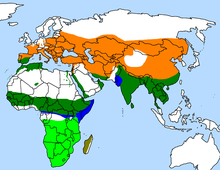
Hornbills are birds found in tropical and subtropical Africa, Asia and Melanesia of the family Bucerotidae. They are characterized by a long, down-curved bill which is frequently brightly coloured and sometimes has a horny casque on the upper mandible. Hornbills have a two-lobed kidney. They are the only birds in which the first and second neck vertebrae are fused together; this probably provides a more stable platform for carrying the bill. The family is omnivorous, feeding on fruit and small animals. They are monogamous breeders nesting in natural cavities in trees and sometimes cliffs. A number of mainly insular species of hornbill with small ranges are threatened with extinction, mainly in Southeast Asia.

Hoopoes are colourful birds found across Africa, Asia, and Europe, notable for their distinctive "crown" of feathers which can be raised or lowered at will. Three living and one extinct species are recognized, though for many years all of the extant species were lumped as a single species—Upupa epops. In fact, some taxonomists still consider all three species conspecific. Some authorities also keep the African and Eurasian hoopoe together but split the Madagascar hoopoe. The Eurasian hoopoe is common in its range and has a large population, so it is evaluated as Least Concern on The IUCN Red List of Threatened Species. However, their numbers are declining in Western Europe. Conversely, the hoopoe has been increasing in numbers at the tip of the South Sinai, Sharm el-Sheikh. There are dozens of nesting pairs that remain resident all year round.

The wood hoopoes or scimitarbills are a small African family, Phoeniculidae, of near passerine birds. They live south of the Sahara Desert and are not migratory. While the family is now restricted to Sub-Saharan Africa, fossil evidence shows that it once had a larger distribution. Fossils attributed to this family have been found in Miocene rocks in Germany.

The Eurasian coot, also known as the common coot, or Australian coot, is a member of the rail and crake bird family, the Rallidae. It is found in Europe, Asia, Australia, New Zealand and parts of North Africa. It has a slaty-black body, a glossy black head and a white bill with a white frontal shield. The sexes are similar. Similar looking coot species are found throughout the world, with the largest variety of coot species living in South America.

The Eurasian curlew or common curlew is a very large wader in the family Scolopacidae. It is one of the most widespread of the curlews, breeding across temperate Europe and Asia. In Europe, this species is often referred to just as the "curlew", and in Scotland known as the "whaup" in Scots.

The Eurasian dotterel, also known in Europe as just dotterel, is a small wader in the plover family of birds. It is the only species placed in the genus Eudromias.

The African grey hornbill is a member of the hornbill family of mainly tropical near-passerine birds found in the Old World. It is a widespread resident breeder in much of sub-Saharan Africa and the southwest of the Arabian Peninsula. The African grey hornbill has escaped or been deliberately released into Florida, USA, but there is no evidence that the population is breeding and may only persist due to continuing releases or escapes.
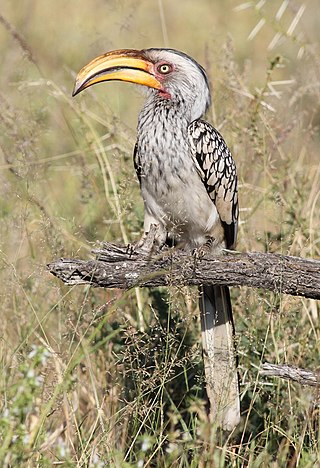
The southern yellow-billed hornbill is a hornbill found in southern Africa. Yellow-billed hornbills feed mainly on the ground, where they forage for seeds, small insects, spiders and scorpions. This hornbill species is a common and widespread resident of dry thornveldt and broad-leafed woodlands. They can often be seen along roads and water courses.
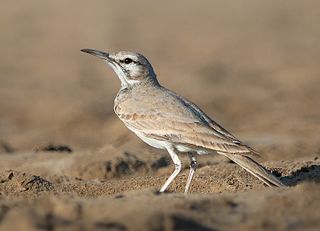
The greater hoopoe-lark is a passerine bird which is a breeding resident of arid, desert and semi-desert regions from the Cape Verde Islands across much of northern Africa, through the Arabian Peninsula, Syria, Afghanistan, Pakistan and India. It was formerly known as the bifasciated lark and sometimes as the large desert lark.

The great hornbill, also known as the concave-casqued hornbill, great Indian hornbill or great pied hornbill, is one of the larger members of the hornbill family. It occurs in the Indian subcontinent and Southeast Asia. It is predominantly frugivorous, but also preys on small mammals, reptiles and birds. It has been listed as Vulnerable on the IUCN Red List since 2018. It is known to have lived for nearly 50 years in captivity. Due to its large size and colour, and importance in many tribal cultures and rituals, the Government of Kerala declared it as the official Kerala state bird. It is also the state bird of Arunachal Pradesh.

The blue-naped mousebird, also formerly called the blue-naped coly is a species of bird belonging to the family Coliidae within the order Coliiformes. They are the sister group to the clade Eucavitaves, which contains the families Leptosomiformes, Trogoniformes (trogons), Bucerotiformes, Piciformes and Coraciformes.

Bucerotiformes is an order of birds that contains the hornbills, ground hornbills, hoopoes and wood hoopoes. These birds were previously classified as members of Coraciiformes. The clade is distributed in Africa, Asia, Europe and Melanesia.
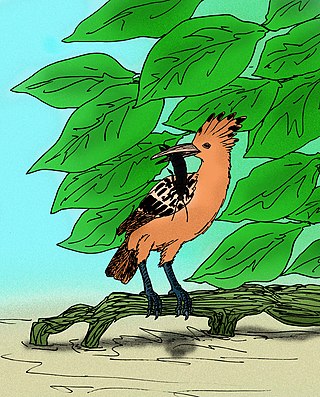
The Saint Helena hoopoe, also known as the Saint Helena giant hoopoe or giant hoopoe, is an extinct species of hoopoe known exclusively from an incomplete subfossil skeleton. Once endemic to the island of Saint Helena, it was last seen around 1550, likely driven to extinction by various aspects of human activity.

The Kentish plover is a small wader of the family Charadriidae that breeds on the shores of saline lakes, lagoons, and coasts, populating sand dunes, marshes, semi-arid desert, and tundra. Both male and female birds have pale plumages with a white underside, grey/brown back, dark legs and a dark bill; however, additionally the male birds also exhibit very dark incomplete breast bands, and dark markings either side of their head, therefore the Kentish plover is regarded as sexually dimorphic.
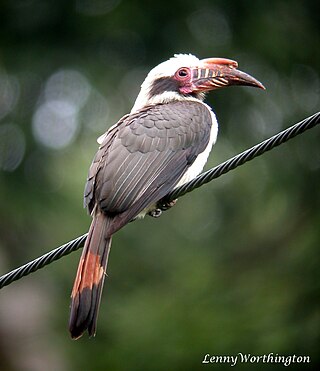
The Luzon hornbill, sometimes called Luzon tarictic hornbill, is a species of hornbill in the family Bucerotidae. It is endemic to forests on Luzon and nearby islands in the northern Philippines. All five Philippine tarictics were once considered a single species. It is declining due to habitat destruction, hunting and the illegal wildlife trade.

The fiery-necked nightjar is a species of nightjar in the family Caprimulgidae, which is found mostly in Africa south of the equator, though it has been spotted in a few countries north of the equator. It is most often found in woodland savannas or other deciduous woodlands. It is usually distinguished by its tawny coloured collar which gives the species its common name. It has a distinctive call that many have rendered as 'good-lord-deliver-us'. The fiery-necked nightjar is an insectivorous species that mostly eats butterflies, moths and other insects. The fiery-necked nightjar breeds after the dry season and typically produce two clutches with two eggs per clutch.

The Madagascar hoopoe is a species of hoopoe in the family Upupidae. It was previously considered a subspecies of the hoopoe, but was split due to its vocalisations and small differences in plumage. Some taxonomists still consider all three species conspecific. Some authorities also keep the African and Eurasian hoopoe together, but split the Madagascar hoopoe. It is endemic to Madagascar, where its natural habitat is subtropical or tropical dry forest. It is a common bird and the International Union for Conservation of Nature considers its conservation status to be of least concern.

The Australasian swamphen, commonly known as the pūkeko in New Zealand, is a striking and socially complex bird found in Oceania, including eastern Indonesia, Papua New Guinea, New Zealand and Australia. A member of the rail family, it is part of the diverse order Gruiformes, which includes species with similar characteristics such as cranes and other rail species. Within the Australasian swamphen species, five recognised subspecies exist, with P. p. melanotus being the most common and widely distributed in New Zealand. They display phenotypic characteristics typical of rails: relatively short wings and strong, elongated bills, adapted to its semi-aquatic lifestyle in wetlands.

The Eurasian hoopoe is the most widespread species of the genus Upupa. It is a distinctive cinnamon coloured bird with black and white wings, a tall erectile crest, a broad white band across a black tail, and a long narrow downcurved bill. Its call is a soft "oop-oop-oop".

Allofeeding is a type of food sharing behaviour observed in cooperatively breeding species of birds. Allofeeding refers to a parent, sibling or unrelated adult bird feeding altricial hatchlings, which are dependent on parental care for their survival. Allofeeding also refers to food sharing between adults of the same species. Allofeeding can occur between mates during mating rituals, courtship, egg laying or incubation, between peers of the same species, or as a form of parental care.

